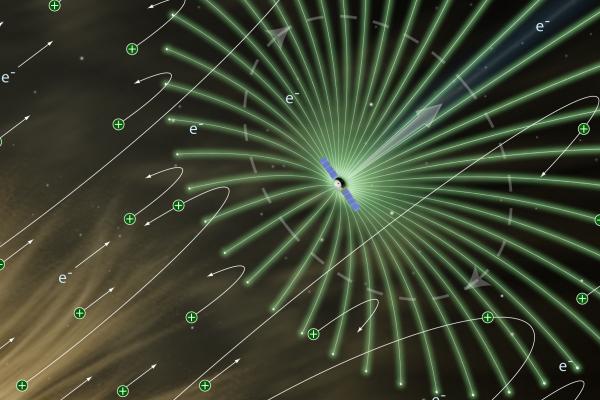The idea, developed by Dr Pekka Janhunen from the Finnish Meteorological Institute, is to stretch out one hundred 20-kilometre-long microscopic tethers around the spacecraft like a giant starfish.A solar sail is meant to give a spacecraft gentle but constant acceleration due to the force of photons from the sun hitting it and pushing it forward. However, the biggest problem with that idea is the sail must be extremely large in order to give it power that is comparable to a chemical thruster, and that makes it too heavy.As part of the EU-funded ESAIL project, Dr Janhunen is exploring an avenue that could skirt this obstacle. The project is pioneering a sail design that intercepts charged particles in the solar wind. Unlike rays of sunlight, the momentum of these particles can be harnessed by deflecting them with weightless electric fields.The field will be generated by charging 20-kilometre-long, aluminium wires – each just 50 micrometres in diameter and weighing barely 200 grams.An electric field would spread 200 metres around each tether, making a total cross-section of 400 square kilometres. That could propel a spacecraft across the inner solar system faster than current propulsion systems, Dr Janhunen said.Although the microscopic diameter of the electric solar sails makes them light, it also makes them vulnerable. Timo Rauhala, an electronics engineer at the University of Helsinki, has therefore developed a way to fasten them into resilient tethers.Micrometeoroids‘We intertwine the wires into a scaffold of metal loops that repeats over kilometres,’ he said. ‘Because the structure is composed mainly of empty space, micrometeoroids are unlikely to break all four wires at any one spot.’Dr Pekka Janhunen, from the Finnish Meteorological Institute.Dr Pekka Janhunen, from the Finnish Meteorological Institute.Computer simulations estimate that, while micro-collisions would sever each 20-kilometre wire in a matter of minutes, the chances of a full fracture in any of the 100 tethers used in a complete propulsion system is no higher than 1 % over a five-year period.The tethers also remain elastic and can be rolled onto reels and packed onto a spacecraft. ‘We have automated the entire bonding process and have shown that it works on a kilometric scale,’ said Dr Janhunen. ‘The next step is to test it in space.’To field-test their invention, the ESAIL consortium has partnered with another EU-funded project, EstSpacE. The project received EUR 1 million to help in the construction of ESTCube-1, Estonia’s first satellite, a nanosatellite, made by more than a hundred undergraduate students at Tartu University, Tallinn University, and the Estonian Aviation Academy.As a result of the collaboration with the Finnish Meteorological Institute and the German Aerospace Centre, ESTCube-1’s primary mission – to deploy a 10-metre-long prototype in space – is now getting underway. The payload was piggybacked on a European Space Agency launch in May 2013 and now orbits the earth 650 kilometres up.“‘The real advantage of electric solar sails is that they use no fuel … they could essentially make space flight lighter, easier and cheaper.’Dr Pekka Janhunen, the Finnish Meteorological InstituteSince the launch, they have been working on the code required to bring the satellite under control using four on-board electromagnets, as they’re afraid the sail might break if it is deployed too early.According to Dr Mart Noorma, who was involved in the project, they should be in a position to deploy the sail, by unreeling it from the spacecraft, in the coming months.‘This is something you can’t practice on earth,’ he said. ‘Deploying the electric solar sail will be an all-in, single-try gamble. The students taking part in the project understand this and are not taking any chances with it.’Lightweight missionsIf the electric solar sail can be proven to work in space, it could ultimately replace chemical thrusters on lightweight interplanetary missions.‘The real advantage of electric solar sails is that they use no fuel,’ said Dr Janhunen. ‘Also, in cases where they make planetary fly-bys (where gravity is used to accelerate a spacecraft) unnecessary, they relax constraints on rocket launch windows. They could essentially make space flight lighter, easier and cheaper.’However, he also stressed the limitations of the technology. The thrust provided by the solar wind is of no use for lifting objects out of earth’s orbit, and it fades quickly beyond the asteroid belt, but it could be used for missions to the inner planets such as Mars.Innovation like this illustrates a growing trend in the space industry. Privatised rocket launches and cheaper electronics are making it easier to test new ideas.‘Projects costing millions of euros cannot afford to experiment with unproven technology,’ said Dr Noorma. ‘But successful concepts and components tried out in nanosatellites like ESTCube-1 can later be picked up by more conventional players.’Nuclear spacecraftThere is no shortage of alternatives for more energy-intensive missions. The EU-funded DiPoP project has investigated several potentially disruptive technologies for generating propulsion and power in space.For larger-scale challenges, such as manned flights to Mars or expeditions to deflect asteroids on a collision course with earth, a nuclear power-driven spacecraft could be best suited to navigating the interplanetary void.Dr Claudio Ferrari from the ISIS R&D centre in Rome said that the fuel efficiency of a nuclear propulsion system could be around ten times higher than the best chemical thrusters around today. The follow-up MEGAHIT project is bringing together partners from the EU and Russia to produce propsals for even higher-power nuclear electric space propulsion systems.For details, visithttp://www.megahit-eu.org/about-megahit.html
This article was originally published in Horizon, the EU Research and Innovation magazine.
Add to favorites:
Share:
Listing Description
Video
Documents
No documents available.
Ask KETMarket to make a contact
Connect with the Listing Owner!
💬 Please log in now to askKETMarket to make a contact. Not a member yet? Sign up for free and start connecting today!
Video
Related Funding and Finance Opportunities
Unlock Exclusive Funding Opportunities!
🔑 Get instant access to tailored funding opportunities that perfectly match your needs. This powerful feature is exclusively available to our premium members—helping you save time, stay ahead of the competition, and secure the right funding faster.
Upgrade to Premium now and never miss an important opportunity again! Already a premium member? Log in here to explore your matches.
Related Innovation Offers
Discover Tailored Innovation Offers!
🚀 Gain access to technology solutions that match your specific needs and interests—carefully selected to support your innovation goals. These offers are exclusively available to our premium members, helping you identify relevant technologies faster and start the right conversations with potential partners.
Upgrade to Premium now and explore your personalized technology matches today! Already a premium member? Log in here to view your tailored offers.
Related Knowledgeable Resources
Discover More with Premium: Related Knowledge Resources
🔒 You’re missing out on expert-curated knowledge specifically matched to this topic. As a Premium member, you gain exclusive access to in-depth articles, guides, and insights that help you make smarter decisions, faster.
Whether you’re preparing a funding proposal, researching a new market, or just need reliable information—our Premium knowledge matches save you hours of research and point you directly to what matters.
Upgrade to Premium now and instantly unlock relevant knowledge tailored to your needs! Already a member? Log in here to view your personalized content.

